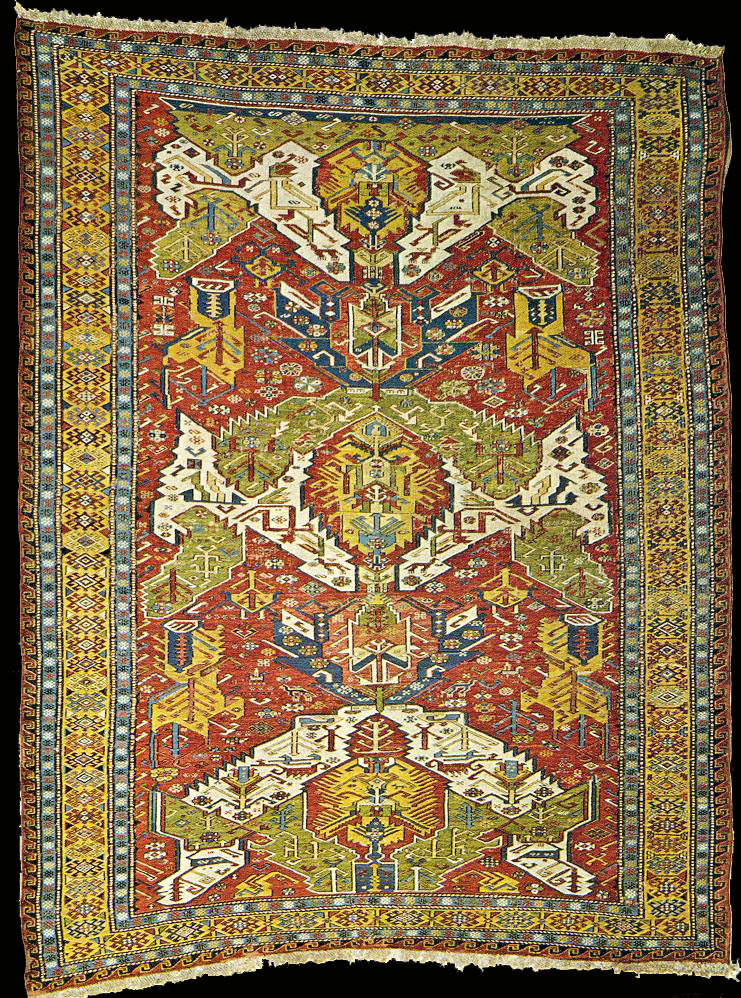|
465 This is the
classic dragon soumak composition. The earliest recorded example, in the
Wher collection, is dated 1223 A.H. (A.D. 1808/9) and other examples are
known with dates only slightly later in the 19th century. Despite the usual
warnings against placing too much faith in the dates found on Caucasian
village weavings, the Wher collection piece is certainly of sufficient
quality to give us some confidence in the authenticity of its date. It has a
particularly beautiful range of colours—a light red ground, ivory, pale blue
and very pale green (leaves), and a frequent use of an unusual shade of
light aquamarine blue. Its composition is much more open and freely drawn
than that found on our 464, and it has the usual outer red-ground running
dog guard. An interesting point, however, is that the dragons on the Wher
carpet have already reached a very exaggerated degree of stylisation.
perhaps even more so than those on the undated, but obviously early, example
in the Metropolitan Museum (Dimand, Oriental Rugs in the Metropolitan Museum
of Art. fig. 242), the latter having a main border composition related to
those seen on our 463 and 467, and which is found on sournaks with a wide
variety of field compositions. The Metropolitan Museum example is very close
both in field and border compositions to the rug illustrated by Schurmann in
Caucasian Rugs (pl. 119), another example with exceptionally beautiful
colour. A third example closely related to the Metropolitan Museum rug was
sold at auction by Lefevre in London on 26 November, 1976 (lot 17); this had
harsher colours and more spikey drawing than the Schürmann piece. Another
rug sold by the same auctioneers on 9 February, 1979. had the same wide
spacing as the Wher example, as well as a very similar colour range
(although its main border was of the same type, but slightly more ornate, as
the Metropolitan Museum rug). The present soumak has dragons no more
stylised than those seen on the Wher and Metropolitan Museum examples;
indeed, the bottom pair, with yellow bodies, dark blue heads and light blue
legs, which flanks the eagle medallions between the two complete series of
interlocking leaves, is, if anything, slightly less stylised. Note also the
pair of two opposing small blue and red motifs seen clearly a quarter of the
way down each side of the bottom large white-ground leaf, motifs which have
been interpreted as mini-renderings of the dragon and phoenix combat. The
place of manufacture of this group of Soumak rugs probably does not differ
from rugs of other designs in the same technique, many of which, as can be
seen from the following examples, have similar borders, minor details of
composition and a closely allied colour range. John Mumford, in one of the
most influential early 20th century carpet books, Oriental Rugs, remarked in
the preface to the fourth edition of 1915, that in the Shirvan region there
had been an independent Khanate of Soumaki, which had existed until the
Russian military conquests in the first half of the 19th century. In the map
found in an early 19th century travel book by the Hon. George Keppel,
Personal Narrative of Travels in Babylonia, Assyria, Media and Scythia in
the Year 1824, extensively quoted by Jean Lefevre in the introduction to his
book Caucasian Carpets, we find marked in the Shirvan area the name
Schamachin, which in Schurmann's map in Caucasian Rugs, has become Soumak.
In the text of his book, Keppel describes 'Nova Shumakia' — "Its present
possessors, the Russians, are repairing the ravages inflicted by Aga Mohumud,
who wrested it from the Tartars in the latter end of the last century." The
town
is built near the ruins of another, much older, own of the same name, "once
the seat of government of a Tartar prince . . . ". We recall that some
current authorities incline to the view in the dragon pile-knotted rugs of
the 16th and 17th centuries were probably not made in the town of Kuba, to
which they were attributed by an older generation of writers, but in royal
workshops established by the Khans further south. The town of Shusha in the
Karabagh has been mentioned in this context but Soumak, not so far to the
north, seems to offer itself as just as likely a candidate. Not a few Soumak
rugs have many details of composition in common with pile-knotted rugs
attributed to the eastern - Caucasus. Indeed, the unusual dragon soumak
illustrated by Roger Gardiner in Oriental Rugs from Canadian Collections
(no. 80), which would seem to be a very late example with an
uncharacteristic floral ground, has an outer Seichur border, a composition
not normally encountered on rugs made outside the eastern regions; it is
also found on many soumaks of differing designs. The minor blue-ground wards
of the present piece, with their rows of tiny flower-heads, are also
characteristic features of Shirvan weaving, being found on many pile-knotted
rugs from this region. Probably second half 19th century. 164 x 205 cm
Lit: Ian Bennett's
Oriental Rugs Volume I
published Ian Bennett's Oriental Rugs Volume I, plate 465
 |

